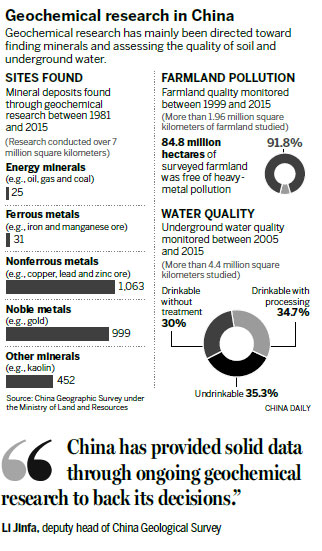Cooperative project with UNESCO will offer valuable data
China inked an agreement with UNESCO on Thursday to launch a global project to create a geochemical map of the Earth that would provide data to assist in finding solutions for pollution and resource shortages.
The project will map the distribution of 92 naturally found elements in the air, water and soil, and could affect scientific decisions on the environment and resources, the China Geological Survey under the Ministry of Land and Resources said on Thursday.
Jiang Daming, minister of land and resources, said the global initiative to create a chemical picture of the Earth is similar to drawing the human genome.
The International Center for Global-scale Geochemistry, based in Langfang, Hebei province, will be the base for the project, and will provide ongoing scientific research and data.
Under the plan, the world's land will be divided into a grid with about 18,000 squares. In the first phase, researchers will collect data on the major 76 chemical components in each square, using analysis and monitoring methods to guarantee consistent results among countries, said Wang Xueqiu, deputy director of the newly built center in Langfang.
The project will also assess resource distribution, heavy metal pollution and radioactive risks in the environment, which could facilitate scientific decisions for economic and social development, Wang said.
For example, through surveys of farmland quality, governments would be better informed about soil conditions and the appropriate crops for such soils, Wang said.
By 2021, the basic geochemical survey will cover 50 elements in 50 percent of the world's land, and will be available on a unified platform.
"China has provided solid data through ongoing geochemical research to back its decisions," said Li Jinfa, deputy head of the national geological survey, on Thursday.
Since 1981, China has found over 4,000 metric tons of gold reserves, leading to its becoming the world's largest gold producing country in 2014, Li said.
In addition, it surveyed groundwater in a 4.4-million-square-kilometer area, covering almost all regions using underground water, said Lin Liangjun, head of the environmental geology department of the national survey authority.
The research also found over 2,410 underground water sources with chemicals good for human health, he said, adding that these resources could be exploited in the future.
China will provide training and cooperate with the world to build a database of chemical components, Jiang, the minister, said.

